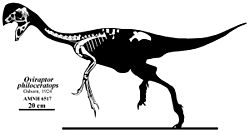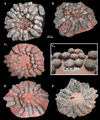Oviraptor facts for kids
Quick facts for kids OviraptorTemporal range: Upper Cretaceous
|
|
|---|---|
 |
|
| Skeletal diagram showing known elements of the holotype specimen (AMNH 6517) | |
| Scientific classification | |
| Kingdom: | |
| Class: | |
| Superorder: | |
| Order: | |
| Suborder: | |
| Family: |
Oviraptoridae
|
| Genus: |
Oviraptor
|
Oviraptor was a fascinating dinosaur that lived about 75 million years ago. Its name means "egg seizer" or "egg thief." This name came from its first fossil discovery in 1924 in Mongolia. Scientists found an Oviraptor fossil right on top of some eggs. At first, they thought it was caught stealing the eggs.
However, later discoveries showed that Oviraptor was likely a caring parent. It was probably protecting its own nest of eggs, not trying to steal them! This makes Oviraptor a great example of how science learns more over time.
Oviraptor lived during the Upper Cretaceous period. Most of its fossils have been found in Mongolia, especially in a famous area called the Flaming Cliffs. A possible second specimen was found in Inner Mongolia, China.
Contents
What Oviraptor Looked Like
Oviraptor was a theropod dinosaur, meaning it walked on two legs. It was about the size of a human, around 6.5 feet (2 meters) long.
Its Unique Head Crest
Many drawings of Oviraptor show it with a tall, bony crest on its head. This crest looks a bit like the one on a modern cassowary bird. However, scientists now think that the most famous tall-crested fossils might actually belong to a close relative called Citipati.
It's likely that Oviraptor did have a crest, but its exact size and shape are still a bit of a mystery. The only well-preserved Oviraptor skull is crushed, making it hard to tell for sure.
Feathers and Beak
Based on its relatives, scientists believe Oviraptor probably had feathers. This would have made it look even more like a large bird.
Instead of teeth, Oviraptor had a strong, toothless beak. We don't know exactly what it ate, but one fossil had the remains of a lizard in its stomach area. This suggests that Oviraptor was at least partly a meat-eater.
The Egg Mystery Solved
The name Oviraptor means "egg seizer" because of its first discovery. In 1924, a fossil was found on a nest of eggs. Scientists thought it was trying to eat the eggs of another dinosaur, Protoceratops.
However, later discoveries changed this idea. In the 1990s, more Oviraptor fossils were found sitting on nests in a brooding position, just like birds do today. The eggs in these nests were also identified as Oviraptor eggs. This proved that Oviraptor was a caring parent, protecting its own young, not stealing from others!
Images for kids
-
The Flaming Cliffs of Mongolia in the Gobi Desert. The first Oviraptor fossils were found here.
-
Skeletal reconstruction of the holotype specimen. Original bones are marked in white.
-
Osborn's line drawing of the holotype skull.
-
A restored skull of Oviraptor.
-
Comparison of the lower jaw of several oviraptorosaur dinosaurs.
-
Complete oviraptorid egg clutches from the Nanxiong Formation.
See also
 In Spanish: Oviraptor philoceratops para niños
In Spanish: Oviraptor philoceratops para niños












